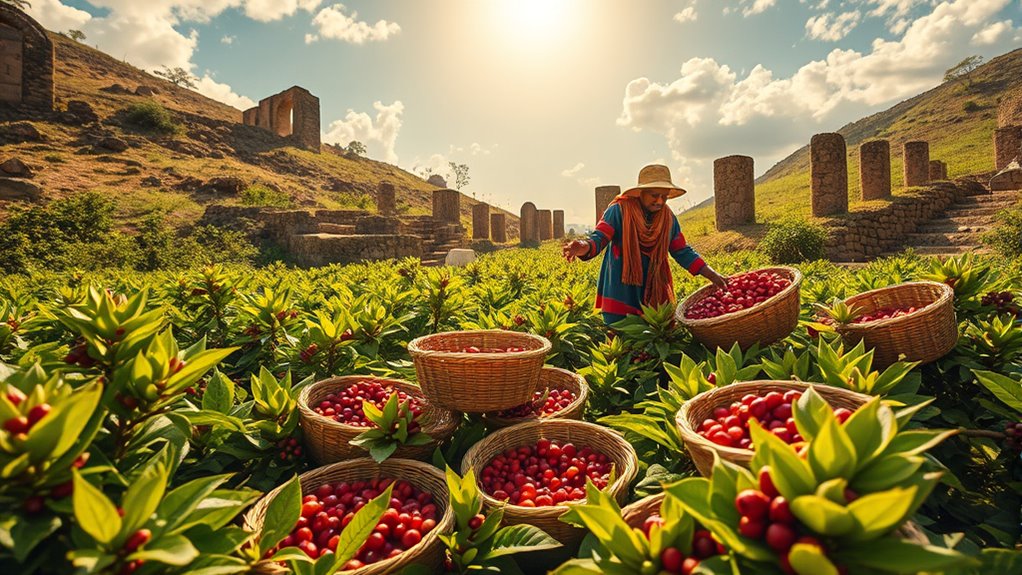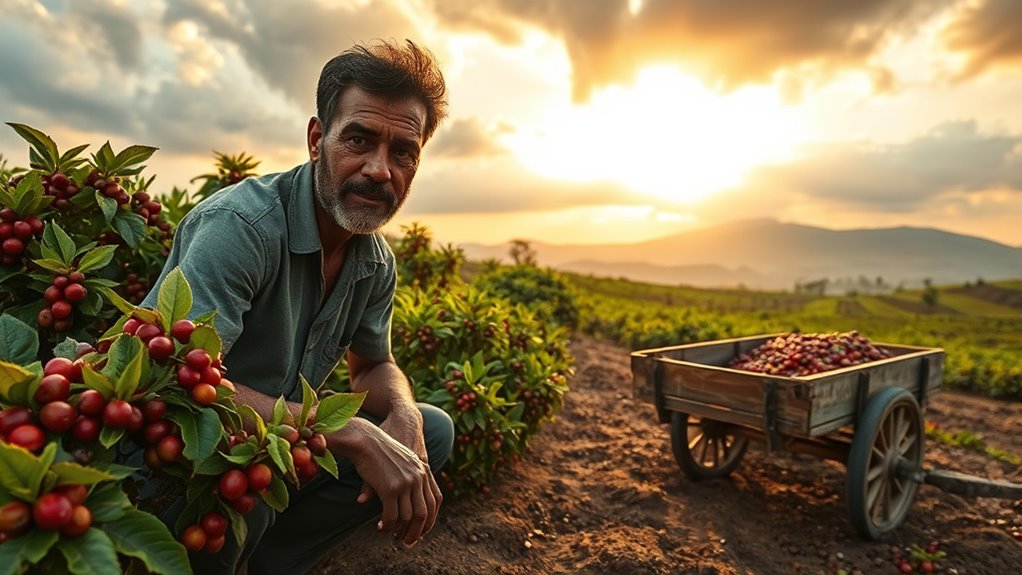Ethiopia’s coffee history traces back over a thousand years, originating in the Kaffa region. The Oromo people crafted early cultivation methods, while the famous legend of Kaldi highlights coffee’s energizing effects. By the 15th century, coffee was exported to Yemen, igniting global interest. Today, Ethiopia boasts over 6,500 Arabica strains, each with unique flavor profiles. However, challenges like climate change and economic pressures threaten this rich heritage. Discover more about how these factors shape Ethiopian coffee today.
Key Takeaways
- Ethiopia is the birthplace of coffee, with its history dating back over a thousand years to the Kaffa region.
- The Oromo people initiated early coffee cultivation and established traditions of consumption that continue today.
- By the 15th century, Ethiopian coffee began exporting to Yemen, increasing global interest in the beverage.
- Ethiopia is home to over 6,500 Arabica coffee strains, contributing to its rich flavor diversity.
- Coffee cultivation is primarily done by over 4 million small-scale farmers using traditional manual techniques, facing economic and environmental challenges.
Origins of Ethiopian Coffee

Ethiopia, often regarded as the birthplace of coffee, has a rich history that dates back over a thousand years.
In the Kaffa region, the coffee plant has thrived in the wild, where it was first discovered. The Oromo people played a crucial role in the early coffee cultivation and consumption, establishing traditions that would shape the future of this beloved beverage.
By the 15th century, Ethiopian coffee began its journey beyond borders, with exports reaching Yemen and sparking global interest.
Today, Ethiopia boasts over 6,500 identified strains of Arabica coffee varieties, showcasing its unique biodiversity.
This remarkable legacy not only highlights the origins of Ethiopian coffee but also sets the stage for its enduring global significance.
The Legend of Kaldi

You might be surprised to learn that the legend of Kaldi, a 9th-century goat herder, is central to the story of coffee’s origins.
His discovery of energetic goats after they ate red berries led to the creation of a beverage that transformed Ethiopian coffee culture.
This tale not only highlights Kaldi’s role but also underscores coffee’s deep cultural significance in connecting communities.
Kaldi’s Discovery Story
As the legend goes, a 9th-century goat herder named Kaldi stumbled upon the energizing effects of coffee when he noticed his goats frolicking with newfound vigor after munching on the bright red berries from a mysterious tree.
Intrigued by their energy, Kaldi decided to try the berries himself. To his delight, he experienced a similar burst of energy.
This discovery sparked curiosity about the potential of the coffee plant, leading Kaldi to share his findings with local monks. They brewed the berries into a drink, which helped them stay awake during long prayers.
This tale not only highlights Kaldi’s connection to coffee but also reflects the rich traditions and folklore that are essential to Ethiopian coffee culture.
Impact on Coffee Culture
While many cultures around the world have embraced coffee, the legend of Kaldi profoundly shaped Ethiopia’s unique coffee culture. This 9th-century goat herder’s discovery of the energizing red berries sparked a tradition that runs deep in Ethiopian society.
Coffee became essential for monks, enhancing their focus during long prayers and spreading throughout the region.
Today, the traditional coffee ceremony showcases Ethiopia’s rich history, involving the roasting, brewing, and serving of Ethiopian coffees as a social ritual. This ceremony not only honors Kaldi’s legacy but also reflects the country’s diverse varietals, making Ethiopia the birthplace of Arabica coffee.
Each cup served symbolizes connection, celebration, and the importance of community in Ethiopian culture.
Cultural Significance of Coffee

In Ethiopia, coffee isn’t just a drink; it’s a way to connect with others.
You’ll find that the coffee ceremony is a cherished tradition, bringing friends and family together to share stories and strengthen bonds.
This rich cultural practice highlights how deeply coffee is woven into the fabric of daily life and community.
Coffee Ceremony Tradition
The Ethiopian coffee ceremony isn’t just about brewing a beverage; it’s a rich cultural tradition that fosters connection among people.
You’ll experience this traditional event in three stages: abol, tona, and baraka, each showcasing unique flavors enhanced by sugar or herbs. As you gather with friends and family, the aroma of roasted coffee beans wafts through the air, heightening your sensory experience and reinforcing the importance of smell in Ethiopian culture.
The djebena, a terracotta pot used for brewing, reflects the artistry and significance of the ceremony. This practice embodies Ethiopia’s cultural identity, symbolizing hospitality and strengthening community bonds, as generations pass down these cherished traditions.
Community Connection Through Coffee
Ethiopian coffee isn’t just a drink; it’s an essential thread that connects communities and enhances social interactions. The coffee ceremony, a daily ritual, symbolizes friendship and hospitality among Ethiopian Christians and diverse groups.
As you participate, you’ll experience:
- The rich aroma of freshly roasted beans wafting through the air.
- The rhythmic sound of coffee grinding, echoing the heartbeat of community life.
- The warmth of shared laughter and stories around a communal pot.
- The blessings exchanged, forging deeper spiritual connections.
This ceremony creates a vibrant tapestry of unity, fostering cooperation and camaraderie.
With about 40% of Ethiopia’s coffee consumed locally, it’s not just an export but a crucial part of daily life, strengthening community bonds across the nation.
Coffee Production in Ethiopia

While many countries are known for their coffee, few can match Ethiopia’s rich heritage and diverse production methods. As the world’s fifth-largest coffee producer, Ethiopia generated 496,200 tonnes in 2022, making it Africa’s top producer.
You’ll find that over 4 million small-scale farmers are actively involved in coffee production, with half of the coffee consumed locally. Coffee cultivation spans around 4,000 km², relying heavily on manual, labor-intensive techniques.
Ethiopia categorizes its coffee into three main types: Forest, Garden, and Plantation Coffees. Each type notably influences the unique flavors you experience.
The European Union is the largest market, accounting for 50% of exports, followed by East Asia and North America, showcasing the global appreciation for Ethiopian coffee.
Diverse Bean Varietals

Despite its small size, Ethiopia boasts an astonishing variety of coffee bean varietals that set it apart as a premier coffee origin.
With over 6,500 identified strains of Arabica coffee, the diversity of Ethiopia’s coffee is remarkable.
Here are some notable coffee varietals you should know:
- Longberry – The largest, highest quality beans known for their sweetness.
- Shortberry – Smaller beans with a balanced flavor profile.
- Sidamo – Fruity and floral notes that dance on your palate.
- Yirgacheffe – Light and aromatic flavors with a bright acidity.
These unique varietals, combined with Ethiopia’s diverse terroir and high altitudes, create complex flavors that coffee lovers around the world cherish.
Traditional Coffee Processing Methods

The remarkable variety of coffee bean varietals in Ethiopia is complemented by a rich tapestry of traditional coffee processing methods that greatly influence the final flavor.
You’ll find methods like wet, dry, natural, and honey processing, each shaping the unique flavor of the coffee.
In the wet process, water removes the fruit covering of the coffee cherries, enhancing delicate flavors and acidity. Conversely, the dry process involves sun-drying the cherries for up to four weeks, resulting in bold, robust flavors.
The natural method retains the cherries during drying, yielding fruity, wine-like characteristics. Ultimately, the honey process leaves some mucilage on the bean, creating a smooth and sweet flavor profile.
Each method brings forth a distinct taste experience.
The Role of Elevation in Flavor Development

When you explore Ethiopian coffee, you’ll quickly notice how elevation plays a vital role in flavor development.
Higher altitudes slow down the maturation of coffee cherries, leading to denser beans with more complex flavors.
This unique environment, combined with rich volcanic soils, creates a tapestry of tastes that truly reflect the region’s diverse topography.
Higher Elevation Benefits
Cultivating coffee at higher elevations reveals a world of flavor possibilities that many enthusiasts crave.
When you explore Ethiopian coffee plants thriving between 1,500 to 2,200 meters, you’ll discover:
- Denser Beans: Slow maturation leads to beans packed with flavor.
- Bright Acidity: Higher elevation enhances the natural acidity, creating a lively cup.
- Distinctive Notes: Floral and fruity characteristics emerge, enchanting your palate.
- Rich Soil: Volcanic soil provides essential nutrients, promoting ideal growth.
These factors contribute to a unique flavor profile that elevates your coffee experience.
The cooler temperatures and lower oxygen levels stress the coffee plants, resulting in richer, more complex flavors.
Whether you’re brewing at home or at a café, these higher elevation beans promise an unforgettable taste.
Flavor Complexity Factors
Higher elevation coffee cultivation not only enhances flavor but also brings complexity to the tasting experience.
When you sip coffee grown at altitudes between 1,500 and 2,200 meters, you’ll notice how the slower maturation rates contribute to denser beans, resulting in richer profiles. Cooler temperatures at these heights allow coffee cherries to develop gradually, which intensifies flavor complexity.
In contrast, coffee plants at lower elevations mature quickly, often leading to simpler flavors. Furthermore, the unique volcanic soil conditions in Ethiopia’s mountains provide essential nutrients and drainage, further influencing the coffee’s characteristics.
With over 6,500 Arabica strains thriving in diverse altitudes, Ethiopia truly showcases the depth and vibrancy of flavors that high-elevation coffee can offer.
Environmental Influence on Coffee
Although many factors influence coffee’s flavor, elevation plays a crucial role in its development. When you consider coffee grown in Ethiopia, particularly at heights between 1,500 to 2,200 meters above sea level, you’ll notice distinct characteristics:
- Complex flavors: Higher elevations allow coffee cherries to ripen slowly, enhancing flavor depth.
- Dense beans: The gradual maturation results in denser beans, packed with flavor.
- Cooler temperatures: These conditions contribute to a more refined flavor profile.
- Unique soils: Ethiopia’s volcanic soils enrich the coffee plants, leading to vibrant flavors.
As you explore these high-altitude coffees, you’ll discover an array of flavor profiles celebrated around the world, making every sip a unique experience.
Impact of Climate Change on Coffee Cultivation

As climate change continues to reshape the environment, Ethiopia’s coffee cultivation faces unprecedented challenges.
You might notice rising temperatures, projected to increase by 1.1 to 3.1 degrees Celsius by 2060, which threaten the ideal conditions for coffee plants.
Altered rainfall patterns lead to longer dry seasons, reducing water availability for irrigation and coffee production. Additionally, the spread of invasive pests and diseases is becoming more rampant, further endangering crops.
The loss of forest cover exacerbates these issues, as forests provide essential shade and habitat for coffee plants.
With over 4 million small-scale farmers relying on this industry, the impacts of climate change put their livelihoods at significant risk, highlighting the urgent need for adaptive strategies in coffee cultivation.
Economic Challenges for Ethiopian Farmers

While Ethiopia remains a leading coffee producer, many farmers face significant economic challenges that threaten their livelihoods. You might picture the struggles of over 4 million small-scale farmers who often receive low prices for their coffee beans.
Here are some key challenges they encounter:
- Fluctuating Market Prices: Unpredictable prices make it hard to sustain a stable income.
- Domestic Market Reliance: With about half of coffee consumed locally, farmers often settle for unfair prices.
- External Market Pressures: Trade agreements and multinational company practices squeeze profit margins.
- Environmental Issues: Climate change jeopardizes coffee yields, making it tougher to sustain crops.
These factors combine to create a formidable landscape for Ethiopian farmers trying to thrive in the coffee industry.
The Influence of Global Brands on Ethiopian Coffee

The influence of global brands on Ethiopian coffee greatly shapes the livelihoods of local farmers. As the birthplace of coffee, where it was first discovered, Ethiopia stands as a significant coffee producer.
However, global coffee giants like Starbucks have faced criticism for blocking trademark applications that could financially empower Ethiopian farmers. Despite a 2007 agreement aimed at improving distribution and marketing, many still doubt whether farmers truly benefit.
While Ethiopian coffee often generates high margins for these brands, farmers receive low prices, highlighting a troubling economic imbalance.
With over 50% of Ethiopia’s coffee exports heading to the European Union, the ongoing debates about fair trade practices underscore the urgent need for equitable agreements that genuinely support local communities.
Frequently Asked Questions
What Is the History of Coffee Cultivation?
The history of coffee cultivation stretches back centuries, evolving from wild plants to cultivated crops. You’ll find that it began with local communities discovering the energizing effects of coffee beans.
Over time, cultivation techniques improved, and trade routes expanded, allowing coffee to spread globally. As you explore its journey, you’ll see how different cultures adopted and adapted coffee, shaping its significance in societies around the world today.
Why Is Coffee so Important in Ethiopia?
Coffee’s importance in Ethiopia goes beyond its economic value; it’s woven into the fabric of daily life.
You’ll find that coffee ceremonies are essential social rituals, fostering community and connection among friends and family.
With around 15 million Ethiopians involved in its production, coffee isn’t just a drink; it’s a cultural symbol.
As you sip, you’re partaking in a rich tradition that’s been cherished for generations, reflecting Ethiopia’s identity and heritage.
Which Animal First Discovered Coffee in Ethiopia?
Imagine a lively dance on a sunlit hillside; that’s how the humble goat first discovered coffee in Ethiopia.
As you watch them prance after munching on red berries, you can almost feel their energy.
It was Kaldi’s curious goats that led him to taste those berries, igniting a passion that would transform cultures.
Did Oromos Discover Coffee?
Yes, the Oromos are credited with discovering coffee.
They first cultivated and consumed coffee beans, using them to create a thick energy-boosting paste.
You might find it fascinating that their observation of goats acting energetically after eating coffee cherries led to this discovery.
The Oromo’s traditional practices have greatly influenced coffee culture, and their contributions continue to shape the global coffee industry today, emphasizing their essential role in coffee’s rich history.
Conclusion
Ethiopia’s coffee story is rich and complex, shaped by legends, culture, and diverse flavors. You’ve explored its origins, celebrated its uniqueness, and recognized the challenges farmers face. As you sip your next cup, remember the journey from Kaldi’s discovery to modern cultivation. Appreciate the distinct beans, the impact of elevation, and the resilience of farmers. By supporting Ethiopian coffee, you’re not just enjoying a beverage; you’re honoring a heritage and embracing a future.









